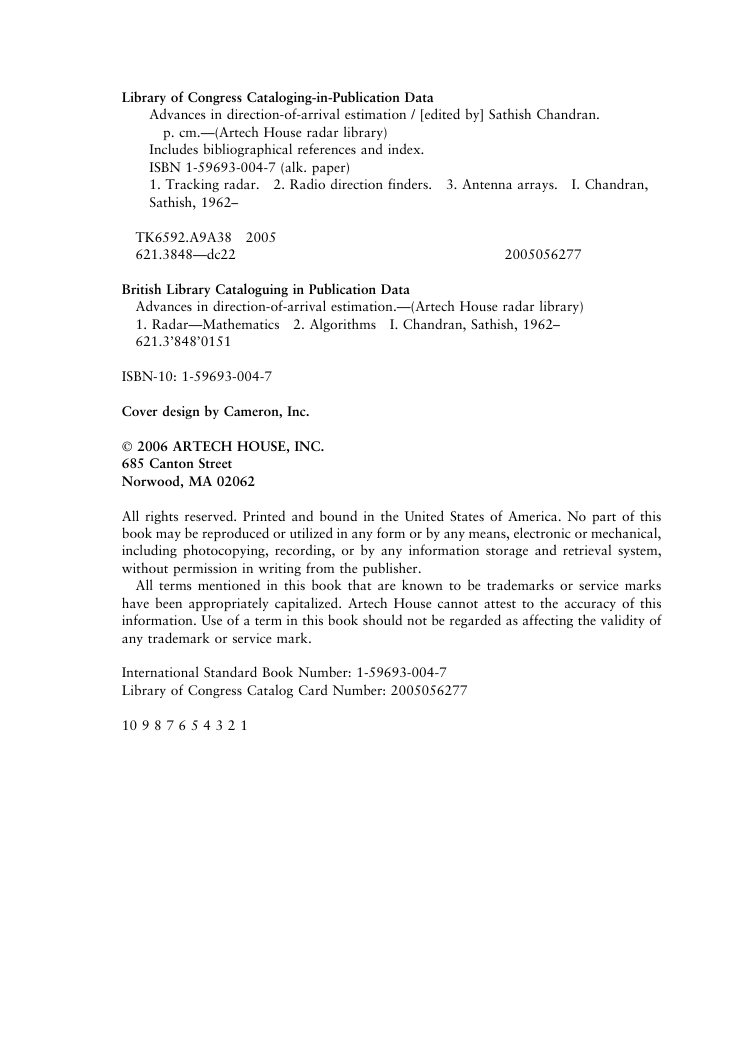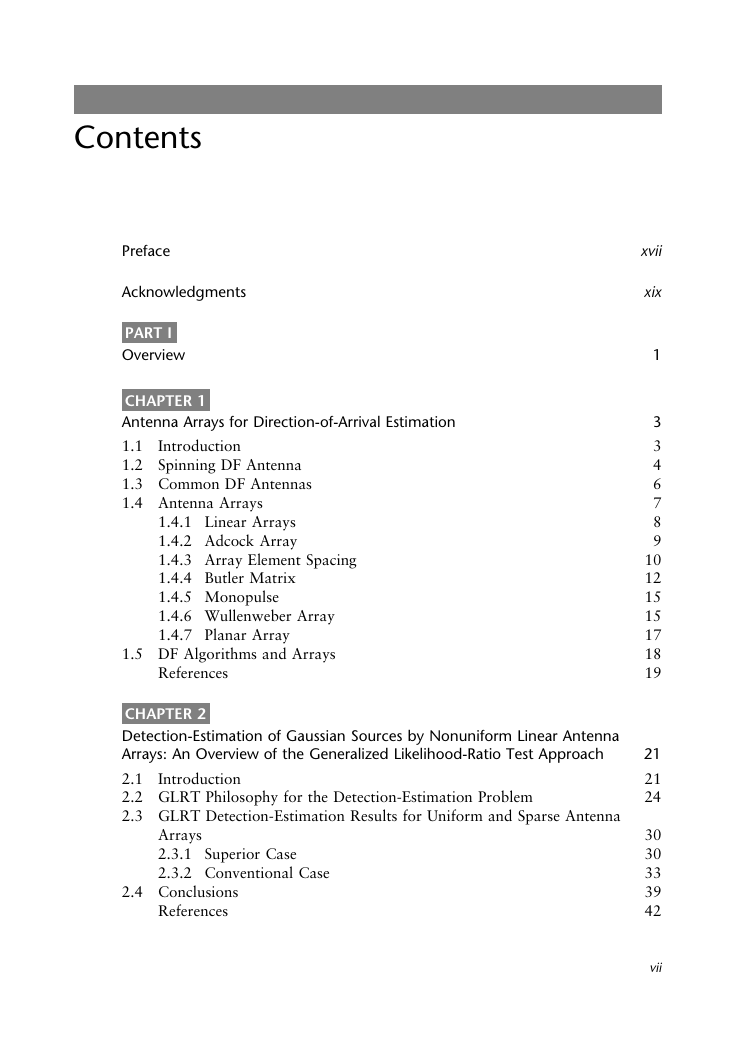Advances in Direction-of-Arrival
Estimation
Contents
Preface
Acknowledgments
Part 1:
Overview
1 Antenna Arrays for Direction-of-Arrival
Estimation 3
1.1 Introduction 3
1.2 Spinning DF Antenna 4
1.3 Common DF Antennas 6
1.4 Antenna Arrays 7
1.4.1 Linear Arrays 8
1.4.2 Adcock Array 9
1.4.3 Array Element Spacing 10
1.4.4 Butler Matrix 12
1.4.5 Monopulse 15
1.4.6 Wullenweber Array 15
1.4.7 Planar Array 17
1.5 DF Algorithms and Arrays 18
References 19
2 Detection-Estimation of Gaussian
Sources by Nonuniform Linear
Antenna Arrays: An Overview of the
Generalized Likelihood-Ratio Test
Approach 21
2.1 Introduction 21
2.2 GLRT Philosophy for the Detection-Estimation Problem 24
2.3 GLRT Detection-Estimation Results for Uniform and Sparse
Antenna Arrays 30
2.3.1 Superior Case
2.3.2 Conventional Case 33
2.4 Conclusions 39
References 42
Part 2: DOA Methods
3 DOA Estimation of Wideband Signals 49
3.1 Incoherent Wideband DOA Estimation 52
3.2 Coherent Wideband DOA Estimation 52
3.2.1 Coherent Signal Subspace Method 53
3.2.2 BICSSM 54
3.2.3 WAVES 55
3.3 TOPS 56
3.3.1 Theory 57
3.3.2 Signal Subspace Projection 62
3.3.3 Performance Assessment 63
3.3.4 Modification of TOPS for Localization 66
3.4 Conclusions 67
Acknowledgments 68
References 68
4 Coherent Broadband DOA Estimation
Using Modal Space Processing 71
4.1 Introduction 71
4.2 System Model 72
4.3 Focusing Matrices for Coherent Wideband Processing 73
4.4 Spatial Resampling Method 74
4.5 Modal Decomposition 75
4.5.1 Linear Arrays 75
4.5.2 Modal Truncation 76
4.6 Modal Space Processing 77
4.6.1 Focusing Matrices 77
4.6.2 Spatial Resampling Matrices 78
4.7 Modal Space Algorithm 79
4.8 Simulation 80
4.8.1 A Group of Two Sources 80
4.8.2 Three Groups of Five Sources 82
4.9 Conclusions 85
References 85
5 Target Localization in Three Dimensions 87
5.1 Direction-of-Arrival Estimation Method 87
5.1.1 Extraction of yi 90
5.1.2 Extraction of zi 91
5.1.3 Extraction of di 91
5.1.4 Pairing yi , zi , and di 92
5.1.5 Complex Amplitude Estimation 92
5.1.6 Noisy Signals 92
5.2 Distance Estimation Method 93
5.3 Target Location Estimation and Simulation Results 96
5.4 Conclusions 101
References 101
6 Polarimetric Time-Frequency MUSIC for Direction Finding of Moving Sources with Time-Varying Polarizations 103
6.1 Introduction 103
6.2 Signal Model 105
6.2.1 Time-Frequency Distributions 105
6.2.2 Spatial Time-Frequency Distributions 105
6.3 Spatial Polarimetric Time-Frequency Distributions 106
6.3.1 Polarimetric Modeling 106
6.3.2 Polarimetric Time-Frequency Distributions 108
6.3.3 Spatial Polarimetric Time-Frequency Distributions 108
6.4 Polarimetric Time-Frequency MUSIC 110
6.5 Spatio-Polarimetric Correlations 111
6.6 Moving Sources with Time-Varying Polarizations 112
6.6.1 Polarization Diversity and Selection of Data Samples 113
6.6.2 Polarization Diversity Consideration in PTF-MUSIC 114
6.7 Simulation Results 117
6.8 Conclusions 118
References 120
7 A One-Dimensional Tree Structure– Based Algorithm for DOA-Delay Joint Estimation 123
7.1 Introduction 123
7.2 System Model 124
7.3 The Proposed Algorithm 127
7.3.1 S-ESPRIT 127
7.3.2 T-ESPRIT 128
7.3.3 TST-ESPRIT 131
7.4 Simulations and Discussions 138
7.5 Conclusions 141
References 141
8 Direction-of-Arrival Estimation Approach Using Switched Parasitic Arrays 145
8.1 Introduction 145
8.2 Switched Parasitic Arrays 146
8.3 Wideband Direction-Finding Method for a Two-Path Model 148
8.3.1 Wideband Signaling in Multipath Environments 149
8.3.2 Method Description 149
8.3.3 Method Performance Analysis 151
8.4 A Modified MUSIC Algorithm for Switched Parasitic Arrays 153
8.4.1 Method Performance Analysis 155
8.5 Conclusions 157
References 159
9 DOA Estimation for Noncircular Signals: Performance Bounds and Algorithms 161
9.1 Introduction 161
9.2 Array Signal Model 162
9.3 MUSIC-Like Algorithms 163
9.3.1 MUSIC-Like Algorithms Built Only from Riy, T 163
9.3.2 MUSIC-Like Algorithms Built from Both Ry, T and Riy, T 164
9.4 Asymptotically Minimum Variance Estimation 170
9.5 Stochastic Crame´r-Rao Bound for Noncircular Gaussian Signals 173
9.6 Stochastic Crame´r-Rao Bound for BPSK Signals 175
9.7 Illustrative Examples 177
9.8 Conclusions 187
References 188
10 Localization of Scattered Sources 191
10.1 Introduction 191
10.2 Array Model 192
10.2.1 Coherently Distributed Source Model 193
10.2.2 Incoherently Distributed Source Model 195
10.3 Parameter Estimation Techniques 197
10.3.1 Estimation Techniques for CD Sources 197
10.3.2 Estimation Techniques for ID Sources 200
10.4 Conclusions 209
References 209
Part 3: Source Localization Problems
11 Direct Position Determination of Multiple Radio Transmitters 213
11.1 Introduction 213
11.2 Mathematical Preliminaries 215
11.3 Position Determination 217
11.3.1 Unknown Waveforms Signals 217
11.3.2 Known Waveform Signals 219
11.4 Numerical Examples 222
11.4.1 Example 1 222
11.4.2 Example 2 223
11.4.3 Example 3 223
11.4.4 Example 4 225
11.4.5 Example 5 225
11.5 Conclusions 225
References 227
Appendix 11.A Crame´r-Rao Bound for Known Waveforms 228
Appendix 11.B CRB for Unknown Gaussian Waveforms 230
Appendix 11.C DPD Performance Analysis for Unknown Waveforms 233
11.C.1 Expressions for Ohmega 234
11.C.2 Expressions for C 235
11.C.3 Special Case: Uniform Linear Array
Appendix 11.D The Frequency Domain Representation of Finite
Length Observations 238
12 Direction-of-Arrival Estimation Under Uncertainty241
12.1 Introduction 241
12.2 Basic DOA Estimation Signal Model 242
12.3 Uncertainties in Signal Model and System Parameters 244
12.3.1 Sources of Uncertainty 245
12.3.2 Improving the Robustness 245
12.4 Uncertainty in Noise Model 247
12.4.1 Qualitative and Quantitative Robustness 248
12.4.2 Robust Procedures 250
12.5 Array Processing Examples 254
12.6 Conclusions 255
References 256
13 Coupling Model in DOA Antenna Arrays 259
13.1 Introduction 259
13.2 Antenna Steering Vector Model 260
13.3 Steering Vector Errors and Their Influence in DOA Estimation 264
13.4 Coupling Model 266
13.5 Coupling Influence in DOA Estimation 272
13.6 Error Compensation 273
13.7 Conclusions 278
References 280
Part 4: Specific Applications of DOA Estimation
14 Maximum Likelihood Estimate of Target Angular Coordinates Under Main Beam Interference: Application to Recorded Live Data 285
14.1 Introduction 285
14.2 MLE Algorithm for Estimation of Target Angular Coordinates 286
14.3 CRLB of Estimation of Target Angular Coordinates 288
14.4 MLE Algorithm Simulation Results 292
14.5 Test on Recorded Live Data 294
14.5.1 Description of the Radar for Data Capture 295
14.5.2 Data Capture Experimental Setup 296
14.5.3 Comparison Between the Theoretical and Real Radar Beams 297
14.5.4 MLE on Recorded Live Data 301
14.6 Conclusions 301
References 302
15 Direction Estimation of Broadband Sources for Auditory Localization and Spatially Selective Listening 305
15.1 Introduction 305
15.2 Scenario and Model 306
15.3 Characteristics of Natural Sound Sources 307
15.4 Decomposing into Spectral Components 308
15.5 DOA Estimation Based on Time Delays and Relative Attenuation 308
15.5.1 General Approach 309
15.5.2 DOA Estimation Using Time Delay Between the Sensors 309
15.5.3 Subspace Methods in a Reverberant Room 310
15.5.4 DOA Estimation Using Relative Attenuation Between the Sensors 311
15.6 Spectrally Weighted DOA Estimate 313
15.7 Source Separation Algorithm 314
15.8 Experimental Results 316
15.8.1 Parameter Values Used in the Implementation 316
15.8.2 Performance of the Algorithm When the Sources Are Sinusoidal 318
15.8.3 Performance of the Algorithm with Increasing Number of Sources 318
15.8.4 Performance of the Algorithm When the Sensor Spacing Is Varied 319
15.8.5 Resolvability of the Algorithm When Sources Are Closely Spaced 320
15.8.6 Performance of the Sound Source Separation from Real Two Sensor Array Recordings in Multitalker Scenario 320
15.8.7 Performance Measure for Listening Tests 321
15.8.8 Performance of the Algorithm with Headlike Structure 322
15.9 Conclusions 323
References 323
Selected Bibliography 324
16 Multiple Target Estimation in a
Surveillance Radar System with a
Mechanically Rotating Antenna 327
16.1 Introduction 327
16.2 Data Model and Problem Statement 328
16.3 The Estimation Algorithm 329
16.3.1 Asymptotic Maximum Likelihood Estimation 329
16.3.2 The AML-RELAX Estimator 332
16.4 Numerical Performance Analysis 334
16.5 Conclusions 342
References 342
17 Joint DOA/DOD/DTOA Estimation
System for UWB Double Directional
Channel Modeling 345
17.1 Introduction 345
17.2 UWB Double Directional Channel Sounding System 346
17.3 Parametric Multipath Modeling for UWB 347
17.3.1 Multipath Model 347
17.3.2 Subband Model 349
17.3.3 Spherical Wave Model 349
17.3.4 Two Single Directional Measurements, Pairing, and Clusterization 350
17.4 ML-Based Parameter Estimation for UWB Directional Channel 351
17.4.1 Maximum Likelihood Parameter Estimation 352
17.4.2 Expectation Maximization Algorithm 352
17.4.3 SAGE Algorithm 353
17.4.4 Successive Interference Cancellation-Type Procedure 354
17.4.5 Consideration About the Subband 356
17.4.6 Deconvolution of Antenna Directivity 356
17.5 Experiments 356
17.5.1 Specification of Measurement Equipment 356
17.5.2 Measurement Environment 357
17.5.3 Results 357
17.6 Conclusions 358
References 360
18 Conventional Method Improvements by Signal Property Exploitation 363
18.1 Cyclostationarity 363
18.2 Data Model 364
18.3 High-Resolution Techniques 365
18.3.1 Cyclic MUSIC Algorithm 365
18.3.2 Extended Cyclic MUSIC Algorithm 365
18.3.3 Root Cyclic MUSIC Algorithm 369
18.4 Nonselective Beamforming Techniques 372
18.4.1 Data Model 373
18.4.2 Beamforming for Cyclostationary Signals 374
18.4.3 Minimum Variance Beamforming for Cyclostationary Signals 374
18.4.4 Discussion 375
18.4.5 Simulations 375
18.5 Conclusions 376
References 377
Part 5: Experimental Setup and Results
19 DOA Antenna Array Measurement and
System Calibration 381
19.1 Introduction 381
19.2 Steering Vector Model 382
19.3 Calibration Process 386
19.3.1 Coupling Through Terminals 387
19.3.2 Radiation Pattern Measurements 388
19.3.3 Calibration Process for the RF Subsystem 389
19.3.4 Application Example 391
19.4 Conclusions 392
References 393
20 ESPAR Antenna Signal Processing for DOA Estimation 395
20.1 Introduction 395
20.2 ESPAR Antenna Fundamentals 397
20.2.1 Structure and Formulation 397
20.2.2 Signal Model 400
20.3 High-Precision DOA Estimation 401
20.3.1 Correlation Matrix for Single-Port Antennas 402
20.3.2 Reactance-Domain Signal Processing 403
20.3.3 Computer Simulations 405
20.3.4 Experimental Verification 408
20.4 Practical System Applications 412
20.4.1 Satellite Attitude and Direction Control 412
20.4.2 Wireless Locator and Homing System 413
20.4.3 Wireless Ad Hoc Network 414
20.5 Conclusions 414
Acknowledgments 415
References 415
21 A New DOA Estimation Method for Pulsed Doppler Radar 419
21.1 Introduction 419
21.2 Review of MUSIC and BS-MUSIC 421
21.3 Model for HF Radar 423
21.4 Two-Dimensional Prefiltering-Based MUSIC 423
21.5 Algorithm Summary for 2DP-MUSIC 427
21.6 Performance Analysis 427
21.6.1 Formulation of Sample Null Spectra for MUSIC, BS-MUSIC, and 2DP-MUSIC 428
21.6.2 Expectation of 2DP-MUSIC’s Null Spectrum 429
21.6.3 Resolution Threshold 430
21.7 Simulations 431
21.8 Experimental Result 433
21.9 Conclusions 435
References 435
Appendix 21.A Derivation of (21.24) 437
Appendix 21.B Resolution of Spectral MUSIC 438
List of Symbols 441
Acronyms 443
About the Authors 445
Index 459
Recent Titles in the Artech House Radar Library
















 2023年江西萍乡中考道德与法治真题及答案.doc
2023年江西萍乡中考道德与法治真题及答案.doc 2012年重庆南川中考生物真题及答案.doc
2012年重庆南川中考生物真题及答案.doc 2013年江西师范大学地理学综合及文艺理论基础考研真题.doc
2013年江西师范大学地理学综合及文艺理论基础考研真题.doc 2020年四川甘孜小升初语文真题及答案I卷.doc
2020年四川甘孜小升初语文真题及答案I卷.doc 2020年注册岩土工程师专业基础考试真题及答案.doc
2020年注册岩土工程师专业基础考试真题及答案.doc 2023-2024学年福建省厦门市九年级上学期数学月考试题及答案.doc
2023-2024学年福建省厦门市九年级上学期数学月考试题及答案.doc 2021-2022学年辽宁省沈阳市大东区九年级上学期语文期末试题及答案.doc
2021-2022学年辽宁省沈阳市大东区九年级上学期语文期末试题及答案.doc 2022-2023学年北京东城区初三第一学期物理期末试卷及答案.doc
2022-2023学年北京东城区初三第一学期物理期末试卷及答案.doc 2018上半年江西教师资格初中地理学科知识与教学能力真题及答案.doc
2018上半年江西教师资格初中地理学科知识与教学能力真题及答案.doc 2012年河北国家公务员申论考试真题及答案-省级.doc
2012年河北国家公务员申论考试真题及答案-省级.doc 2020-2021学年江苏省扬州市江都区邵樊片九年级上学期数学第一次质量检测试题及答案.doc
2020-2021学年江苏省扬州市江都区邵樊片九年级上学期数学第一次质量检测试题及答案.doc 2022下半年黑龙江教师资格证中学综合素质真题及答案.doc
2022下半年黑龙江教师资格证中学综合素质真题及答案.doc